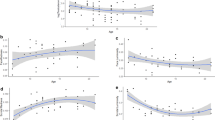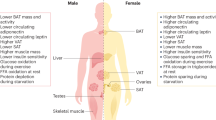Abstract
Sexual selection is a well established evolutionary process based on preferences for specific traits in one sex by members of the other sex. It is important in the evolution of morphological traits, and several sexually dimorphic traits in humans, such as facial hair and facial shape1, are assumed to be the outcome of such a process. Here we demonstrate that taller men are reproductively more successful than shorter men, indicating that there is active selection for stature in male partners by women.
Similar content being viewed by others
Main
There are well known academic2, social3,4, health5,6,7,8,9 and economic10,11 correlates of height, but we know of no studies that have examined its direct implications for evolutionary fitness. To examine the possible evolutionary consequences of stature, we have analysed data from the medical records for 4,419 healthy men aged 25–60 who received compulsory medical examinations between 1983 and 1989 at the Lower Silesian Medical Centre in Wroclaw, Poland. Because the records were not anonymous and many bachelors admitted to having offspring, the risk of false declarations was probably small.
To avoid any confounding pathological effects, we discarded the data from men whose height was more than three standard deviations from the sample mean (172±6.6 cm). Locality of residence had a significant effect on stature (analysis of variance (ANOVA): F3,4409=11.02, P<0.001, with city-dwellers being taller than rural men), so we selected only individuals resident in either rural villages or in cities with more than 100,000 inhabitants (the extreme subpopulations). This yielded a final sample size of 3,201.
Stature is also confounded by a secular trend (linear regression against age: b=−0.00157, F1,3199=184.5, P<0.0001), so we calculated a residual from the common regression line against age for each subject and standardized this against the overall mean for the subject's residence. Stature is also confounded by educational achievement, probably because this correlates with family wealth and status, so we controlled for education.
Figure 1a shows means and variances in stature residuals for men with and without children. When all other variables are held constant, childless men are significantly shorter than those who have at least one child (ANOVA: childedness, F1,3198=25.5, P<0.001; education, F1,3198=93.1, P<0.001). Multiple regression with number of children as the dependent variable, with height and age as independent variables, provides quantitative confirmation of these results (one-tailed tests: city, r2=0.136, n=1,826; height, P<0.001; age, P<0.001; rural, r2=0.208, n=1297; height, P=0.041; age, P<0.0001).
Comparisons of means for individual age cohorts (Fig. 1b) reveals that men with children are significantly taller than childless men in each case (twenties, t1157=−2.97, P=0.005; thirties, t1115=−3.49, P=0.001; forties, t514=−3.06, P=0.002), except for men in their fifties (t409=0.17, P=0.863). Because these men were born during the 1930s, they entered the marriage market shortly after the Second World War when the population sex ratio was highly skewed in favour of women and sexual selection on males would have been greatly reduced as a result: the sex ratio for adults of working age (18–64 for men, 18–60 for women) in Wroclaw was 114.3 women to 100 men in the post-war decade, but fell to 104–105:100 in subsequent decades12.
These results indicate that the effect of height on reproductive output might be due to shorter men being disadvantaged in the search for a mate. This idea is supported by the fact that bachelors were significantly shorter than married men (ANOVA with residual height as the dependent variable, childedness as the covariate, and marital status as the independent variable: F1,3198=7.82, P=0.005).
References
Perret, D. et al. Nature 394, 884–887 (1998).
Teasdale, T. W., Owen, D. R. & Sørensen, T. I. A. Human Biol. 63, 19–30 (1991).
Macintyre, S. & West, P. Sociol. Health Illness 13, 149–166 (1991).
Bielicki, T. & Szklarska, A. J. Biosoc. Sci. 31, 525–536 (1999).
Holl, R. W., Schroder, H. & Heinze, E. Deutsch. Med. Wochenschr. 116, 928–934 (1991).
Barker, D. J. P. et al. Ann. Hum. Biol. 17, 1–6 (1990).
Bogin, B. Patterns of Human Growth (Cambridge Univ. Press, 1988).
Herbert, P. R. et al. Circulation 88, 1437–1443 (1993).
Kee, F. et al. Int. J. Epidemiol. 26, 748–756 (1997).
Komlos, J. Stature, Living Standards and Economic Development (Univ. Chicago, 1994).
Schumacher, A. J. Hum. Evol. 11, 697–701 (1982).
Rocznik Statystyczny Miasta Wroclawia (Miejski Ursad Statystyczny we Wroclawiu, Wroclaw, 1971).
Author information
Authors and Affiliations
Corresponding author
Rights and permissions
About this article
Cite this article
Pawlowski, B., Dunbar, R. & Lipowicz, A. Tall men have more reproductive success. Nature 403, 156 (2000). https://doi.org/10.1038/35003107
Issue Date:
DOI: https://doi.org/10.1038/35003107
This article is cited by
-
Association between childhood obesity and infertility in later life: a systematic review of cohort studies
BMC Endocrine Disorders (2023)
-
The Interacting Effects of Height and Shoulder-to-Hip Ratio on Perceptions of Attractiveness, Masculinity, and Fighting Ability: Experimental Design and Ecological Validity Considerations
Archives of Sexual Behavior (2023)
-
Facial and body sexual dimorphism are not interconnected in the Maasai
Journal of Physiological Anthropology (2022)
-
Femme/Butch/Androgyne Identity and Preferences for Femininity Across Face, Voice, and Personality Traits in Chinese Lesbian and Bisexual Women
Archives of Sexual Behavior (2022)
-
Do blind people share the tall-man stereotype?
Current Psychology (2021)
Comments
By submitting a comment you agree to abide by our Terms and Community Guidelines. If you find something abusive or that does not comply with our terms or guidelines please flag it as inappropriate.




